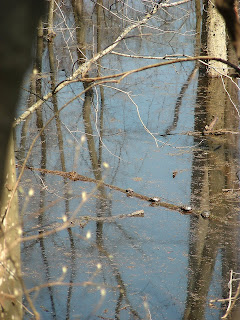 Box-elder (Acer negundo) flowers
Box-elder (Acer negundo) flowers
We took three ambitious walks over the long weekend to firm up after a winter whose exercise consisted largely of upper body work (i.e., snow shoveling). Two of the walks were mostly for sheer movement and exercise, but yesterday we returned to Valley Forge National Historical Park and walked the River Trail that parallels the south shore of the Schuylkill River to see how far spring had advanced since our visit two weeks ago.
 River Trail, Valley Forge National Historical Park. Here, the trail is bordered with lesser celandine (Ranunculus ficaria) and Virginia bluebells (Mertensia virginica)
River Trail, Valley Forge National Historical Park. Here, the trail is bordered with lesser celandine (Ranunculus ficaria) and Virginia bluebells (Mertensia virginica)Valley Forge is a great place to walk, but ecologically it's a disaster. There's a huge deer herd that's culled only through (numerous) automobile accidents and by hunters when deer unwittingly cross the border of the park onto private land. As a national park, there's no hunting allowed inside the boundary. In addition, the natural habitat is badly fragmented, so the landscape is beset by all the problems inherent in largely unmanaged, fragmented habitat--especially invasive vines and groundcovers. Right now, the scourge of the Eastern floodplains, lesser celandine, is everywhere.
 Corky sweetgum trees (Liquidambar styraciflua) and Virginia bluebells on the bank of the Schuylkill River
Corky sweetgum trees (Liquidambar styraciflua) and Virginia bluebells on the bank of the Schuylkill River Virginia bluebells and lesser celandine in bloom
Virginia bluebells and lesser celandine in bloom
The western half of the 3-mile River Trail follows a narrow course between the Schuylkill River and a formidable (obviously man made) embankment about twenty feet high. I had always assumed on our relatively frequent visits that the embankment was the edge of a huge fill--that the area behind the embankment had been used for a landfill or for clean fill from construction. I'd never really investigated. On this walk, though, I proposed that we take an alternate route back to our starting place (rather than just walk out and back on the same trail as we usually do). We climbed the embankment, thinking it led to the alternate trail I sought--and instead of finding a flat plain on top of fill, we entered another world!
The area behind the embankment wasn't solid landfill as I had suspected--the embankment was a levee, created most likely to prevent flooding from the river and to allow the land behind the levee to be farmed. Over the years, though, the area behind the embankment began to retain water, and now it supports a long series of interconnected forested swamps. It was beautiful and exciting. We walked back on a well-worn but unofficial trail along the forested crest of the levee--the swamps one side and the River Trail and Schuylkill River on the other. We felt like we'd stumbled onto a strange new world.
 Hidden swamp
Hidden swamp Basking turtles in the hidden swamp
Basking turtles in the hidden swamp Stately sycamore (Platanus occidentalis) on the edge of the hidden swamp
Stately sycamore (Platanus occidentalis) on the edge of the hidden swamp
 I love bladdernuts. The shrub grows in two large clusters (I suspect it's clonal) along the creek in the natural area I frequent most often. The flowers are short-lived (like all spring ephemerals) and beautiful, but, of course, the real treat comes in the fall. That's when the fertilized flowers produce the unmistakable papery, Chinese-lantern-like tripartite seed pods (the "bladders"). When the fruit is ripe, the seeds loosen inside and become miniature rattles. What's not to like about this plant?
I love bladdernuts. The shrub grows in two large clusters (I suspect it's clonal) along the creek in the natural area I frequent most often. The flowers are short-lived (like all spring ephemerals) and beautiful, but, of course, the real treat comes in the fall. That's when the fertilized flowers produce the unmistakable papery, Chinese-lantern-like tripartite seed pods (the "bladders"). When the fruit is ripe, the seeds loosen inside and become miniature rattles. What's not to like about this plant?






























